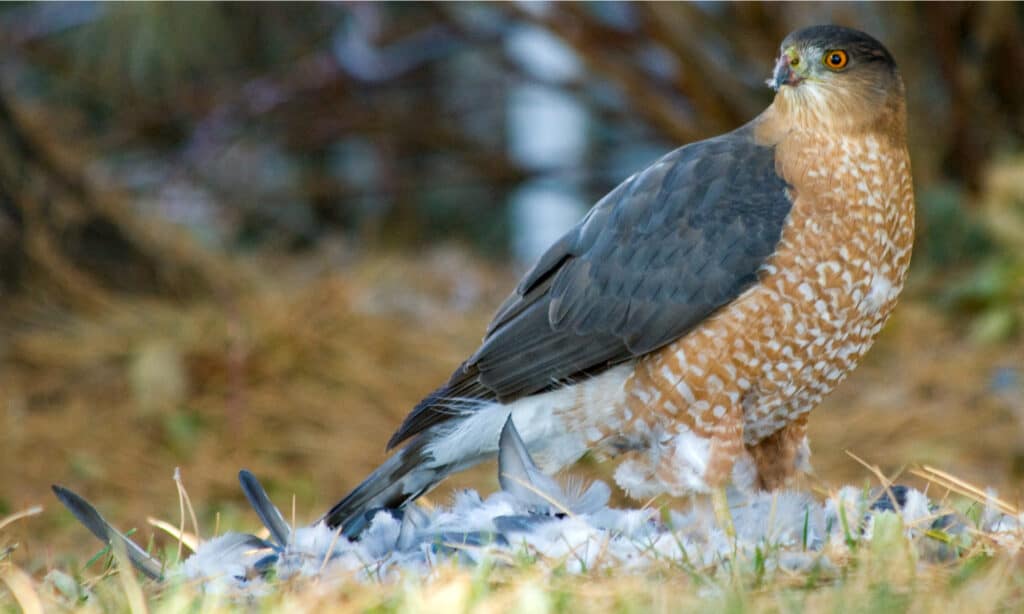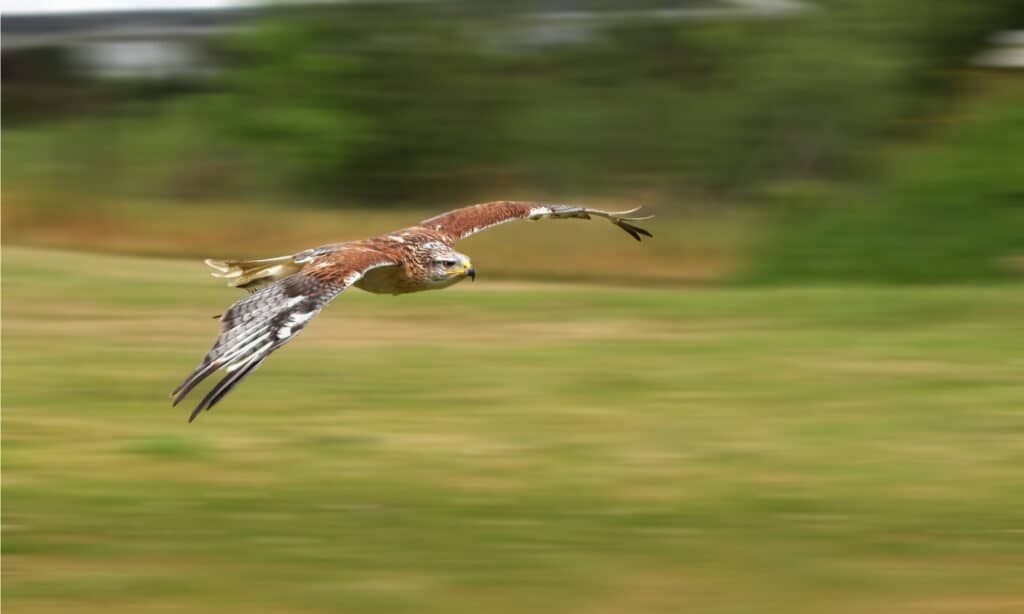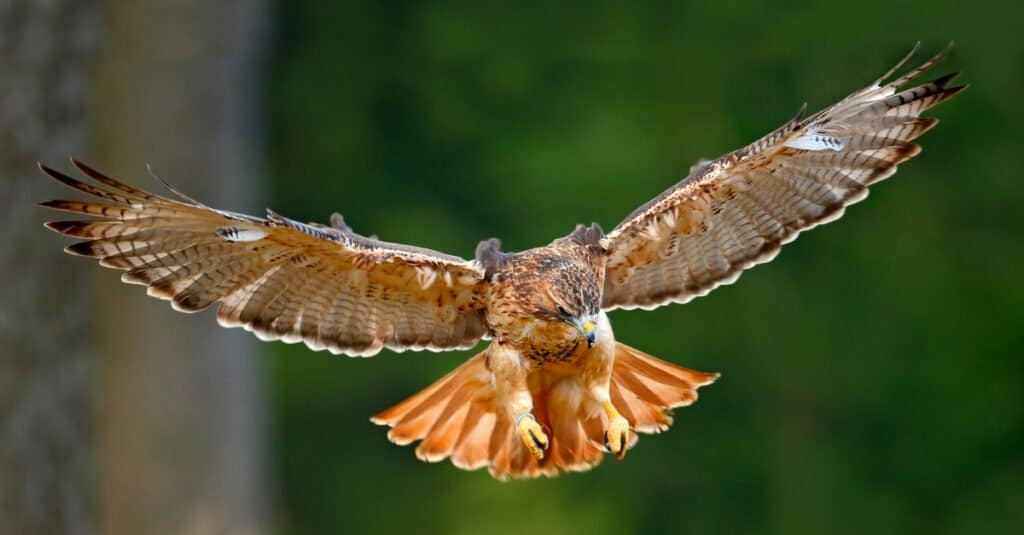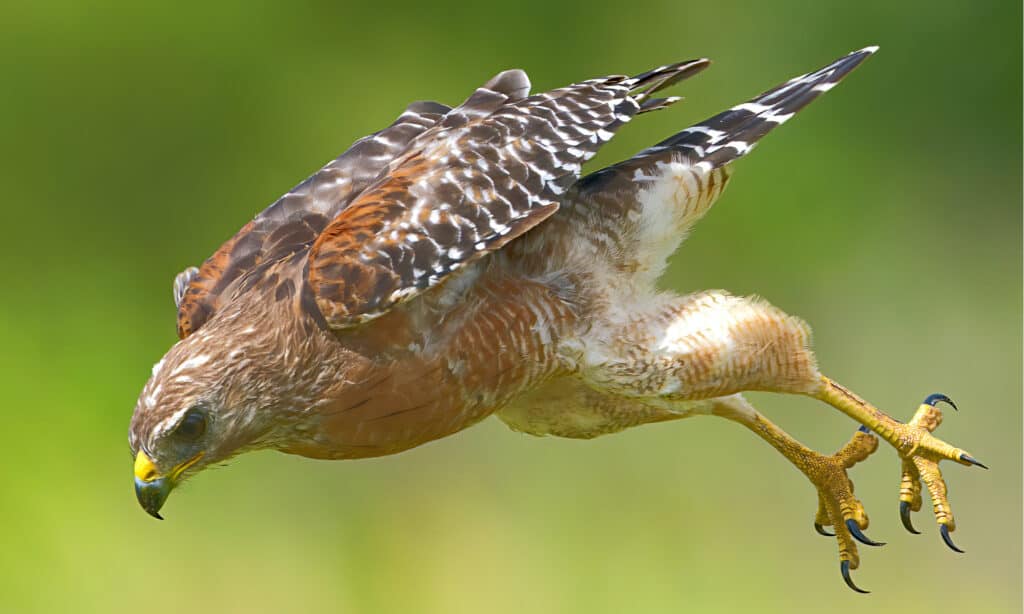South Carolina has a diverse and striking ecosystem that provides habitat to several species of birds, including hawks. The state encompasses the Appalachian highlands and the Atlantic coastal habitats – just in a more compact area. Birders can find different species of hawk in the open grasslands, high ridges, marshes, and woodlands.
Hawks are birds of prey with sharp curved beaks, sharp talons on their feet, and good eyesight. Their patterns and the color of their plumage vary wildly across species. They live virtually in every kind of ecosystem in South Carolina, save for extreme polar regions. They inhabit temperate regions with warm or cold weather depending on the season.
Here are the six types of hawks that are commonly found in South Carolina.
1. Sharp-shinned Hawk

Sharp-shinned hawks have blue-gray featherings above and a copper barring on their white underparts.
©Wyatt W/Shutterstock.com
| Sharp-shinned Hawk | |
|---|---|
| Scientific name | Accipiter striatus |
| Weight | 2.9-7.7 oz (82-219 g) |
| Height | 9.1-15 in (23-37 cm) |
| Wingspan | 17-27 in (42-68 cm) |
Sharp-shinned hawks are the smallest species of hawks in South Carolina. They are very similar to Cooper’s hawks but are about one-third smaller. They are found throughout the forested regions of South Carolina, and their range covers most of North America. They are highly migratory species often spotted in the state in non-breeding seasons. They are always seen around bird feeders, actively searching for songbirds and other small birds.
Sharp-shinned hawks have blue-gray featherings above and a copper barring on their white underparts. Their preferred habitats are wooded and forested regions, but they will also nest in backyards or wooded suburban areas. Females lay between 4-5 eggs in a clutch. Females do most of the incubation, which lasts about 30-35 days.
2. Cooper’s Hawk

Cooper’s hawks build their nests on top of tall trees, usually deciduous or coniferous.
©Richard G Smith/Shutterstock.com
| Cooper’s Hawk | |
|---|---|
| Scientific name | Accipiter cooperii |
| Weight | 7.8-14.5 oz (220-410 g) |
| Height | 14-20 in (35-50 cm) |
| Wingspan | 24-39 in (62-99 cm) |
Cooper’s hawks are medium-sized birds of prey with long, lean bodies. They are very similar to sharp-shinned hawks; you’d think they were their larger versions. They are very common in South Carolina, and you’re most likely to see them in the backyards and within the bird feeders searching for small birds to prey on. They are blue-gray on top with several white and black bands at the tip of their tails.
Cooper’s hawks inhabit the open woodlands, river groves, mature forests, and near the wood edges. These hawks build their nest on top of tall trees, usually deciduous or coniferous. They may also use a pre-existing foundation like that of a large bird or squirrel as their nest. Females lay between 3-5 pale bluish-white eggs that hatch in about 34-36 days.
Cooper’s hawks primarily feed on medium-sized birds, reptiles, chipmunks, ground squirrels, tree squirrels, bats, and mice, among others. They usually perch on a raised structure or top of a tree and watch for prey. When they spot prey, they quickly swoop down and seize it.
3. Broad-winged Hawk

Broad-winged hawks feed on voles, shrews, chipmunks, frogs, lizards, and small birds during summer or nesting seasons.
©pr2is/Shutterstock.com
| Broad-winged Hawk | |
|---|---|
| Scientific name | Buteo platypterus |
| Weight | 9.3-19.8 oz (264-561 g) |
| Height | 13.4-17.3 in (34-44 cm) |
| Wingspan | 31.9-39.4 in (81-100 cm) |
Broad-winged hawks are commonly sighted in South Carolina, especially in the summer and spring months. They are dark brown above, with whitish underparts and a chest containing horizontal barring. They breed in deciduous and mixed forests, where they can easily forage in meadows and wetlands. Females lay 2-3 whitish eggs that hatch in about 28-31 days.
Their diet varies depending on the time of the year. Broad-winged hawks feed on voles, shrews, chipmunks, frogs, lizards, and small birds during summer or nesting seasons. They feed on crabs, snakes, insects, and other small mammals in winter. These hawks hunt by watching for prey from a perch or by flying through the woods in an attempt to take prey by surprise.
4. Northern Harrier

Northern harriers’ diet consists of small birds and mammals.
©Harry Collins Photography/Shutterstock.com
| Northern Harrier | |
|---|---|
| Scientific name | Circus hudsonius |
| Weight | 11-27 oz (300-750 g) |
| Height | 21-25 in (53-64 cm) |
| Wingspan | 41-46 in (103-117 cm) |
Northern harriers are long-winged and long-tailed hawks found in South Carolina during the winter. Males are grayish on top with whitish underparts and black wingtips. Females and young ones are warm brown. They have a conspicuous white patch on their rump in all plumages.
These hawks are found in any kind of terrain, in both dry and wet habitats. You can find them in open fields, prairies, and marshes. They prefer nesting in the marshes. Females lay between 4-6 eggs in a clutch. The incubation period lasts about 30-32 days and is done mainly by females.
Northern harriers hunt in fields and marshes. They either fly low while scanning the ground or may try to locate prey in dense cover. Their diet consists of small birds and mammals, but they can take bigger prey like ducks and rabbits. They sometimes try to overpower larger animals by drowning them.
5. Red-tailed Hawk

Red-tailed hawks build their nests on top of tall trees or cliff ledges.
©Ondrej Prosicky/Shutterstock.com
| Red-tailed Hawk | |
|---|---|
| Scientific name | Buteo jamaicensis |
| Weight | 1.5-3.5 lbs (680-1586 g) |
| Height | 18-26 in (45-65 cm) |
| Wingspan | 43-56 in (110-141 cm) |
Red-tailed hawks are the most common hawks in South Carolina. They are named after the reddish coloration on their tail tips. Their plumage varies from dark-brown to gray-brown with light brown or cream undersides. Females are larger than males.
These hawks inhabit deciduous forests and open areas like plains, tundra, deserts, swamps, or agricultural lands. They build their nests on top of tall trees or cliff ledges. Both males and females build nests that are often re-used for more than a season. Females lay between 2 and 3 eggs in a clutch that both parents incubate for 28-35 days.
Red-tailed hawks hover over open lands, searching for prey like rats, voles, rabbits, small birds, squirrels, snakes, and a variety of other small mammals. They have very sharp eyesight and can see even the slightest movement in the grass below. Upon spotting prey, they swoop down to attack using their sharp talons.
6. Red-shouldered Hawk

Red-shouldered hawks actively search for prey while soaring over woodlands or perched on treetops.
©Chase D’animulls/Shutterstock.com
| Red-shouldered Hawk | |
|---|---|
| Scientific name | Buteo lineatus |
| Weight | 1-1.7 lbs (486-774 g) |
| Height | 15-24 in (38-61 cm) |
| Wingspan | 35-50 in (90-127 cm) |
Red-shouldered hawks get their name from the reddish-colored feathers on their shoulders. They are permanent residents of South Carolina and are commonly sighted throughout all regions of the state. Red-shouldered hawks are also known as the hawks of the woodlands since they live and breed in forests and wooded areas.
These raptors have very clear and conspicuous whistled calls you’d likely hear before seeing them. Their plumage is more visible when they are perched. They are dark above with pale spots and long yellow legs. The immatures have crescent-like wing markings.
Red-shouldered hawks are solitary and very territorial birds of prey. They build their nests in deciduous trees, usually in the fork of the main trunk or on the main branches. Females lay between 3 and 4 pale bluish-white eggs with brown spots. Eggs hatch in roughly 33 days.
Red-shouldered hawks prefer hunting during the day. They actively search for prey while soaring over woodlands or perched on treetops. They sometimes fly low to surprise prey when in clearings. They feed on gophers, moles, mice, chipmunks, large insects, small birds, and snakes. These hawks also attack large animals like tree squirrels and rabbits.
The photo featured at the top of this post is © Ondrej Prosicky/Shutterstock.com
Thank you for reading! Have some feedback for us? Contact the AZ Animals editorial team.






